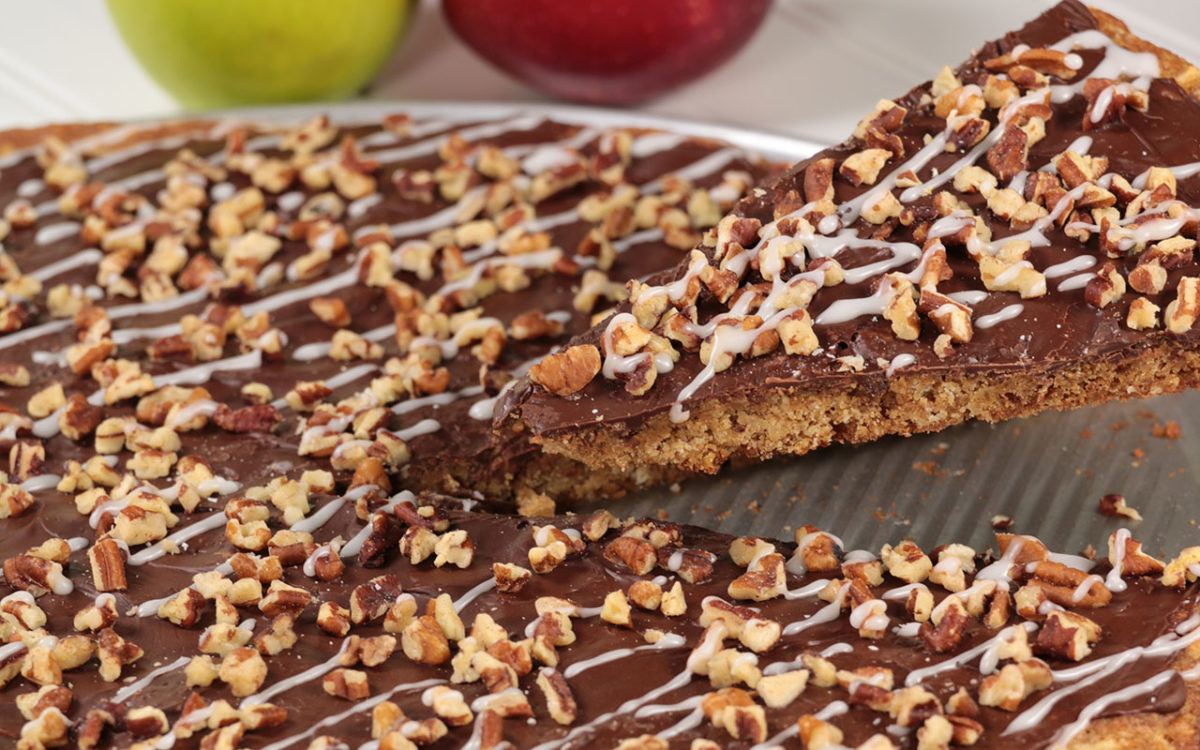- ¾ cup (1 ½ sticks) unsalted butter, softened
- ¾ cup granulated sugar
- ½ cup packed brown sugar
- 1 large egg
- 1 teaspoon pure vanilla extract
- 1 ½ cups all-purpose flour
- 1 ½ teaspoons ground cinnamon
- ¾ teaspoon baking soda
- ¾ teaspoon salt
- 1 cup shredded apple (medium shred)
- ¾ cup quick-cooking oats
- 1 cup (6 ounces) semisweet chocolate chips or butterscotch chips
- ¼ cup finely chopped pecans
- ½ cup sifted confectioners’ sugar
- 1 teaspoon pure vanilla extract
- 2 - 3 teaspoons whole milk
-
Preheat oven to 375°F. Spray a 14” round pizza pan with non-stick cooking spray.
-
In bowl of stand mixer fitted with paddle, beat butter, sugar and brown sugar until light and fluffy. Mix in egg and vanilla. Stop mixer and scrape bowl.
-
Add flour, cinnamon, baking soda and salt; mix until batter is smooth. Stir in shredded apple and oats.
-
Using a spatula, spread the batter into prepared pan leaving 1” around the edge as the batter will spread during baking.
-
Bake 15 – 17 minutes, until golden and a wooden pick inserted into the center comes out clean. Remove from oven and immediately sprinkle chocolate chips over top. Let stand 5 minutes. Chips will soften and look shiny; spread melted chips over top. Sprinkle with pecans. Let cool completely.
-
In a small bowl, whisk together confectioners’ sugar, vanilla and milk until smooth. Drizzle over cookie. To serve, cut into wedges.
-
Variation: Sprinkle M&M’s® Candy over chocolate in place of pecans.
-
NUTRITION INFORMATION PER SERVING (1 SLICE, 51g): 200 calories, 90 calories from fat, 10g total fat, 5g saturated fat, 0g trans fat, 25mg cholesterol, 115mg sodium, 28g total carbohydrate, 1g dietary fiber, 19g sugars, 2g protein, 16mcg folate, 0mg vitamin C, 1mg iron.
-

Learn more about the wheat in your food.
Being around for 10,000 years might mean a few changes in appearance. Modern wheat looks a little different than early, heritage wheat varieties. After all that time, phenotypes (or how a plant looks) are not the only changes. There also came changes in the genetic makeup of wheat. Modern wheat is now able to produce more grain; shorter stems cut back on wheat blowing over in the strong wind, and these varieties are more tolerant of drought. Today, there is a whole new wave of change sweeping the scientific community. New technology has the potential to allow rapid improvements to wheat, like getting even more grain from each head, improving nutritional benefits and the potential to eliminate problems for those who are sensitive to gluten. But what is gene editing?
Gene editing is exactly what it sounds like. It is working within the wheat’s genetic information by turning on or shutting off certain traits that are already present. Gene editing mimics what occurs naturally. Sometimes traits are exposed, and other times natural glitches happen where certain genes are altered. This leads to evolution and genetic advancements. These natural glitches can help the plant to be better suited for the environment and can give it a competitive edge. The plant reproduces and passes on the altered gene. Eventually, this trait becomes ingrained in the makeup of the plant.
